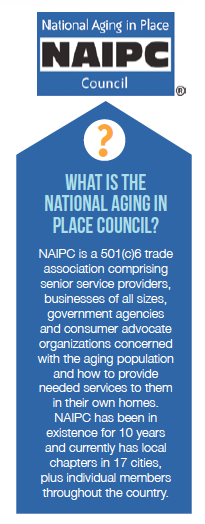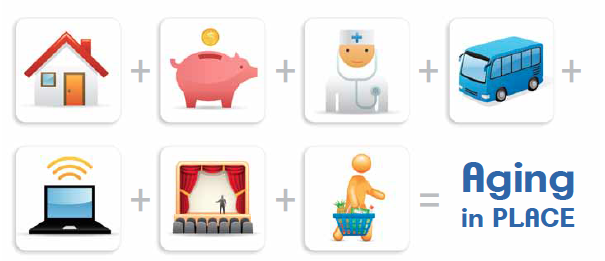What is “aging in place”? A term of art, a nuanced phrase, but what is it really?
At its simplest, aging in place is a choice—the choice of aging Americans to remain in their family homes, to downsize and move into smaller residences, or to join retirement communities. Aging in place comes in many different flavors, but at its core is that choice. The aging in place movement provides seniors with the support and resources they need to have options, to appreciate those options and become aware of what is available to them. The key to utilizing these options is to take a holistic approach, to thoroughly understand each aspect of what often becomes an overwhelming maze.
The National Aging in Place Council (NAIPC) spearheads a movement to provide aging Americans with the services, security, support, resources and comfort to remain in the home of their choice as they grow older. Our mission is to organize aging in place and to transform it from an abstract idea into a lifestyle supported on a multitude of fronts. We aim to increase awareness of aging in place; create useful solutions and tools to help boomers and seniors plan and facilitate their choice; to explore the role of the private sector and small businesses to further the aging-in-place agenda through economic growth, job generation and the creation of products and services; and to stimulate a public policy approach that will benefit individual citizens, families and our society as a whole.
Aging in place represents the coming together of businesses, federal and local government, and both the for-profit and nonprofit sectors to provide a better life for more people. It is an acknowledgment that, by ourselves, we cannot make as much of a difference in anyone’s life as we can together. This involves housing, health care and wellness, personal finance, transportation, academia, community involvement and social interaction, as well as the organization of one’s everyday affairs. It includes advice, education, socialization, empathy and mutual support.
 Almost 90 percent of people over 65 say they want to live in their homes and communities as long as possible, according to a report by the AARP Public Policy Institute and the National Conference of State Legislatures. A whopping 80 percent believe they will stay in their homes until they die. For some, friends and a familiar setting are the main draw, and for others, it’s an emotional attachment to the house and setting. But all too often, the support and the home-based services are not easily accessed to make this possible, especially for those caught in the middle—neither qualifying for public entitlements nor able to pay for services critical to enabling them to remain in their homes and communities.
Almost 90 percent of people over 65 say they want to live in their homes and communities as long as possible, according to a report by the AARP Public Policy Institute and the National Conference of State Legislatures. A whopping 80 percent believe they will stay in their homes until they die. For some, friends and a familiar setting are the main draw, and for others, it’s an emotional attachment to the house and setting. But all too often, the support and the home-based services are not easily accessed to make this possible, especially for those caught in the middle—neither qualifying for public entitlements nor able to pay for services critical to enabling them to remain in their homes and communities.
Increasingly, policymakers and local leaders are recognizing the benefits of providing such services. They are recognizing that the costs are far lower and the social benefits much higher in helping someone to age in the home than to go into a care facility.
Until recently, there was no national approach to aging in place, no federal policy agenda, and no national outcry to expand participation. In 2013, NAIPC began to change that. We gathered our membership at an annual meeting, followed by a meeting of policy experts for an Aging in Place Summit to discuss and strategize the process of filling these voids and figuring out the aging-in-place maze.
Members of NAIPC understand the maze and work every day to help their clients navigate it. Our members are providers in fields that cover the spectrum of services that seniors may need to age in place: technology companies, caregivers, financial planners, geriatric care managers, nonprofit stakeholders, home modifiers, elder law attorneys and reverse mortgage professionals, to name a few. Our members are not only experts in their respective fields, but are also well versed in the scope of aging-in-place services. Organized into chapters nationwide, NAIPC members form local senior support networks. They learn about other chapter members’ businesses and services so that they are better able to serve their own clients and can confidently make referrals to other trusted, vetted professionals. They both advocate and educate. They set themselves apart by trying to understand as much as possible every corner and
crevice of the maze in their local communities.
All NAIPC chapters include at least one reverse mortgage professional—not surprising, since HECMs can play an integral role in successfully aging in place. Particularly for seniors who are asset-rich but income-poor, a reverse mortgage can be the key to a long-term financial strategy. A reverse mortgage can be used to buy a new home better suited to a senior’s current needs. It can be used to cover the costs of Universal Design home modifications. It can be used to pay for health insurance for seniors who retire before they are Medicare-eligible, or to finance emergency medical costs, long-term care, or even technology products that enable seniors to stay comfortably in their homes.
NAIPC members in the reverse mortgage industry understand the diverse ways their product can assist with aging in place, and the better that aging-in-place providers in other fields understand the benefits of a reverse mortgage—especially as part of a well-managed retirement portfolio—the more they understand the ways reverse mortgages can impact their own senior-oriented businesses and provide them with much-needed options. NAIPC chapter involvement from reverse mortgage professionals is a win-win proposition that benefits not only the members and their businesses, but also the communities they serve.




